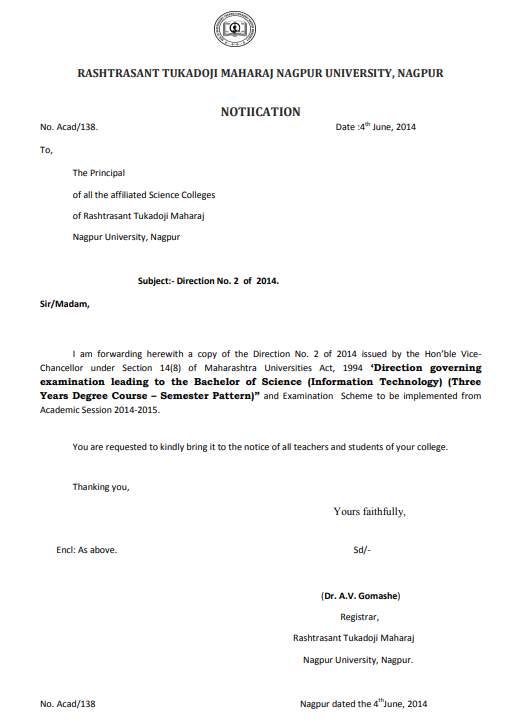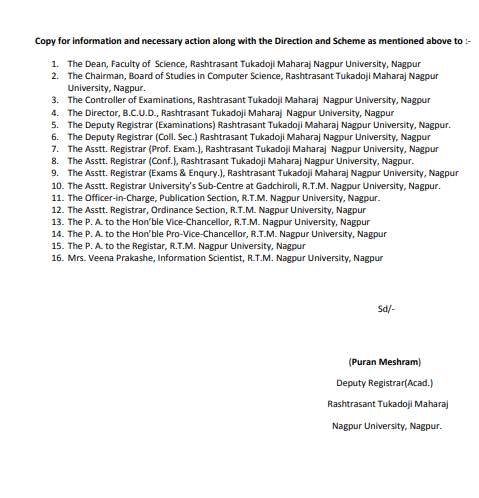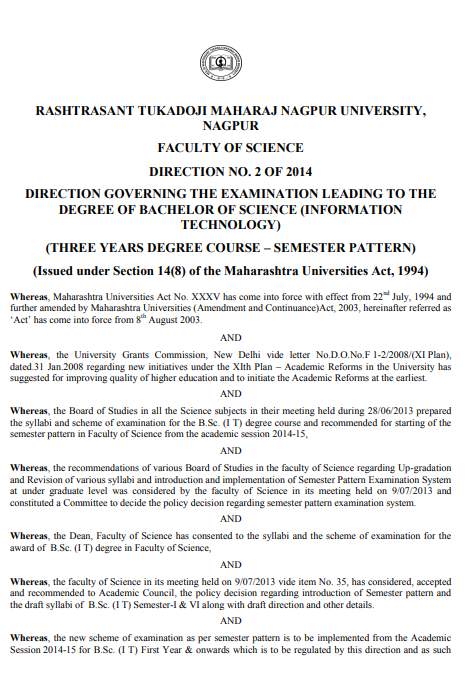|
#2
16th July 2015, 04:35 PM
| |||
| |||
| Re: RTM Nagpur university question papers
Rashtrasant Tukadoji Maharaj Nagpur University was established in 4 August, 1923 with six affiliated colleges, it is a state university, As you are looking for the BSC final year question paper of RTM Nagpur university for preparation so here I am giving you in Image format… RTM Nagpur university BSC final year question papers 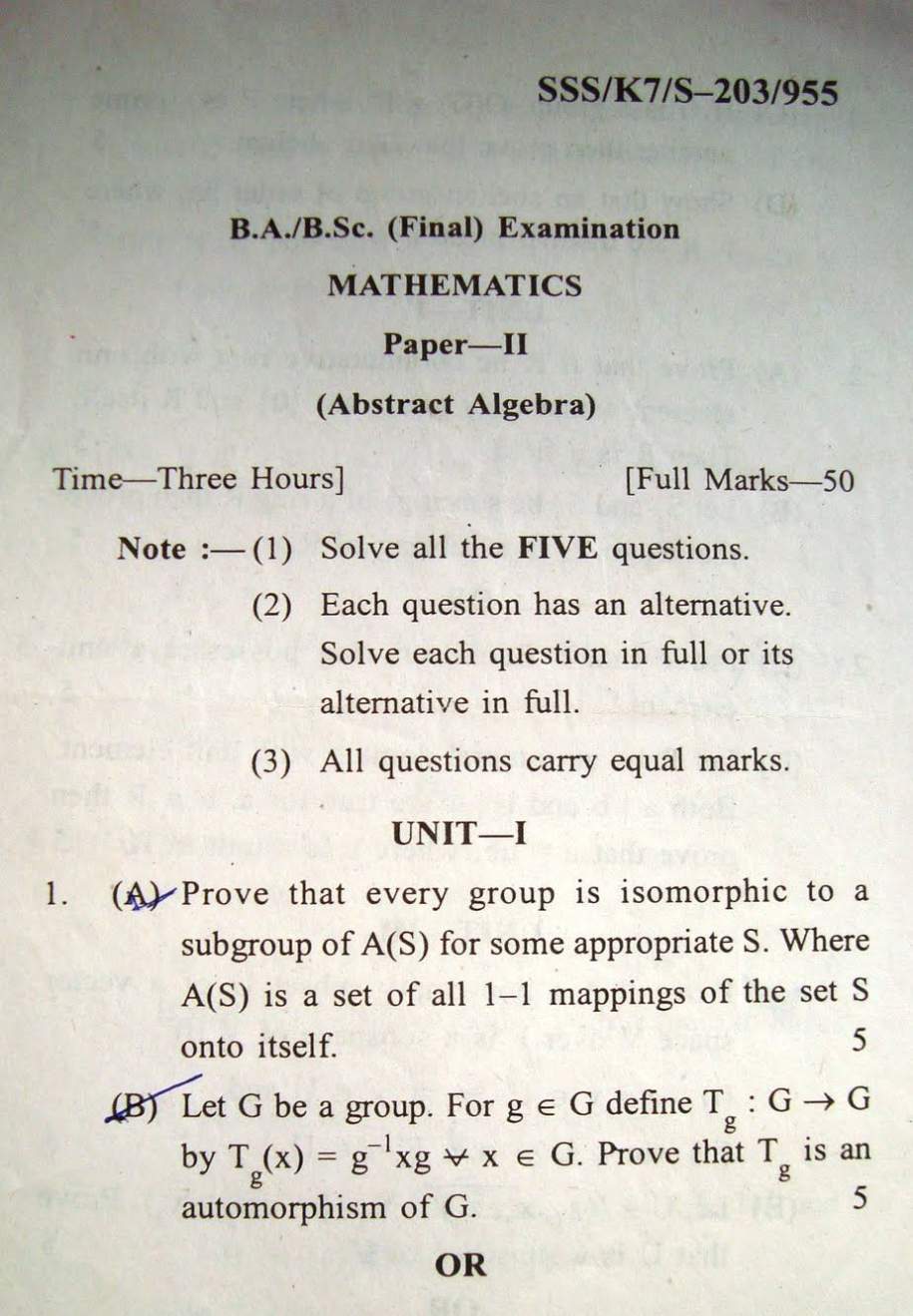  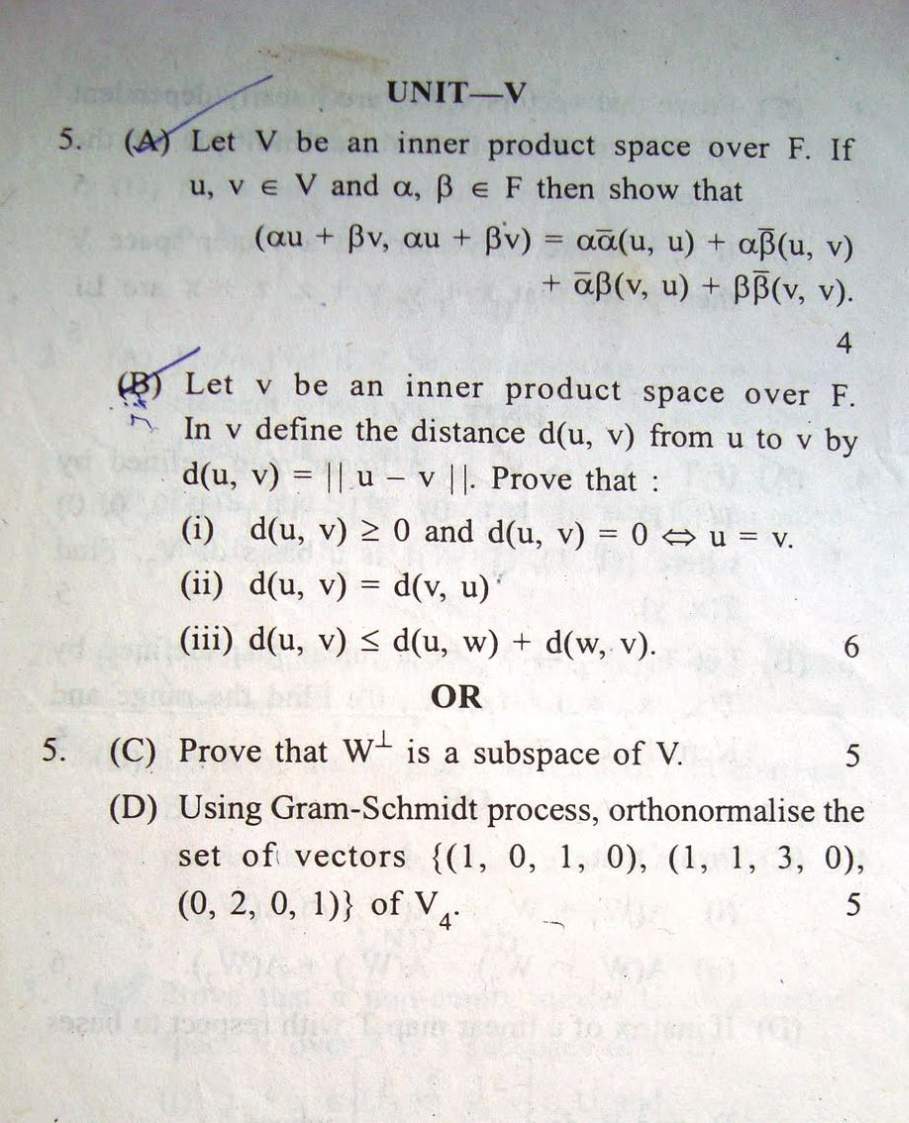 And you are also looking for final year Botany syllabus of Bsc so here I am providing you the same…… SEMESTER – V PAPER – I BIOCHEMISTRY & PLANT PHYSIOLOGY-I Unit I Carbohydrates: Definition, properties and role; Classification: Aldoses and ketoses; monosaccharides, disaccharides and polysaccharides; Structure of Glucose and starch Lipids: Definition, properties and role; fatty acids, oils and waxes, phospholipids, sphingolipids, sterols Aminoacids- Chemistry of amino acids present in proteins (Classification), peptide bond Basics of Enzymology: Nomencleture, Characteristics and properties of Enzymes, factors affecting enzyme activity, Holoenzyme, Apoenzyme, Co-enzymes & Co-factors, Regulation of Enzyme Activity (Enzyme-Substrate Complex Theory), Mechanism of Action (Lock & Key Model, Induced Fit Model) Unit II Plant-water relations: Properties of water, diffusion, diffusion pressure deficit and its significance; Osmosis: Concept, types, osmotic potential and its significance; Imbibition: concept and significance Water conduction through xylem: Root pressure theory, cohesion-adhesion theory; transpiration; stomatal opening mechanism with reference to K+-malate hypothesis Phloem transport: Munch hypothesis Unit III Mineral nutrition: Role and deficiency symptoms of macro- and micro- nutrients (N, P, Fe, Mn, B , Ca); Solute transport: passive (Donnan’s equilibrium), active (carrier concept) Lipid metabolism: Glyoxylate cycle and beta- oxidation Respiration: Structure of ATP, types (aerobic and anaerobic respiration), respiratory substrates and Respiration quotient, glycolysis, Kreb’s cycle, oxidative phosphorylation (ETS), chemiosmotic potential theory; fermentation (alcohol and lactic acid), photorespiration Unit IV Photosynthesis: concept, definition, significance, photosynthetic pigments and their role, action spectra, Emerson’s enhancement effect, red drop mechanism; photolysis of water (Hill’s reaction), cyclic and non-cyclic photophosphorylation, Light independent reactions: C3, C4 and CAM pathways and their significance; factors affecting photosynthesis Nitrogen metabolism: Mechanism of biological nitrogen fixation, importance of nitrate reductase List of practicals To study the effect of various chemicals on permeability of membranes. To study the ascent of sap in suitable plant material. To separate chlorophyll pigment by paper chromatography. To determine the RQ of given plant material. To perform microchemical tests for determination of reducing and non-reducing sugars, starch, cellulose, oils and proteins. To study the effect of light intensity and quality, CO2 concentration and temperature on rate of photosynthesis by suitable method. To determine osmotic potential of the cell sap by plasmolytic method. To study the activity of enzyme amylase, catalase and peroxidase. SEMESTER – V PAPER – II PLANT ECOLOGY - I Unit I Ecology: definition, branches and significance of ecology Climatic Factors: Atmospheric (Gaseous composition), Light & Temperature (effect on vegetation) Unit II Edaphic Factor : Pedogenesis, Soil profile, Soil properties (physical and chemical) Physiographic factor- Biotic Factor: Interactions between plants and animals and human, Interaction between plants growing in a community, Interactions between plants and soil microorganisms. Unit III Ecosystem: Biotic and Abiotic components, Food chain, Food web, Ecological pyramids Biogeochemical Cycles: Nitrogen Autecology (definition, importance), ecad, ecotype- characteristics and importance Synecology (or community ecology)- Study of community: analytical (quantitative- frequency, density, abundance; qualitative- Life forms, Raunkier’s Biological spectrum) and synthetic characters (presence, fidelity, dominance) Unit IV Plant succession: Definition, Causes of succession, Hydrosere, Xerosere Plant adaptations: Morphological, Anatomical & Physiological responses of Hydrophytes, Xerophytes, Halophytes (with one example) List of practicals: To determine frequenct, density, abundance of the community by quadrate method. To determine the homogeneity of vegetation by Raunkiers frequency diagram. To study the morphological and anatomical characteristics of anyone hydrophyte and xerophyte. To study the morphological characteristics of cladode, phylloclade, phyllode and pneumatophores. To determine the water holding capacity of the given soil samples. To determine the water rising capacity of the given soil samples. To determine the soil moisture of the given samples. Botanical Excursions (One short tour is compulsory). Semester V Practical examination Question Paper Time : 5 hrs Marks : 30 Q. 1) To perform given Physiology Experiment [A] & report the findings 06 Q. 2) To perform the given Biochemical Experiment [B] & report the findings 04 Q. 3) To perform the given Ecological Experiment [C] & report the findings 05 Q. 4) To perform the given microchemical test [D] & report the findings 03 Q. 5) Spotting : 04 E - Plant Physiology F - Biochemistry G - Ecology (morphology) H -Ecology (anatomy) Q. 6) Viva Voice 03 Q. 7) Practical Record & Excursion Report 05 SEMESTER – VI PAPER – I PLANT PHYSIOLOGY-II & BIOTECHNOLOGY Unit I Growth: Concept, growth curve, phases of growth Phytochromes: Pr and Pfr forms, their role Circadian rhythms and biological clock Plant growth regulators: Role of auxin, cytokinins, gibberilins, ABA and ethylene Plant movements: Tropic and nastic movements Unit II Photoperiodism: physiology of flowering, photoperiodism and vernalization, role of florigen Senescence and abscission Seed dormancy: Causes and role, methods to break seed dormancy Plant defence: Definition: Hypersensitive response and Systemic acquired resistance; Role of secondary metabolites (Terpenes and phenolic compounds) Unit III Plant tissue culture: History, definitions of- totipotency, explant, asceptic culture, in vitro, micropropagation; methods of sterilization (autoclaving, dry heat, chemicals), culture media (MS media) Callus and organ culture (shoot tip, leaf disc, anther, ovary, ovule and endosperm) and its application Protoplast culture and its application, cybrid production Cell suspension culture and its application Unit IV Genetic engineering: Tools- Enzymes (Restriction enzymes, ligases, DNA polymerases), Vectors (Plasmid vectors- cloning and expression vector) DNA library: cDNA and gDNA library Introduction of rDNA into host: Calcium chloride mediated cell transformation Agarobacterium tumefaciens mediated gene transfer, structure of Ti plasmids Advantages and disadvantages of transgenic plants List of Practicals To determine seed viability by a convenient method Principle and working of: oven, autoclave, laminar air flow hood To study the structure of following vectors on the basis of photographs and diagrams: plasmid vector, Binary vector To study the effect of various plant growth regulators on the growth and development of plants SEMESTER – VI PAPER – II PLANT ECOLOGY, TECHNIQUES & ETHNOBOTANY Unit I Principles of Phytogeography, Distribution (wides, endemics, discontinuous species), Theories (Landbridge and continental drift), Climatic regions of India, Phytogeographic regions of India (Chatterjee 1962; Name, distribution area, typical vegetation) Unit II Environmental Pollution: Agricultural. noise and thermal pollution, Control of environmental pollution, Environmental management Natural resources- types (renewable and non-renewable), factors for depletion; conservation of forest and water resources Unit III Principle, types and application of: microscopy (Light, fluorescent, phase contrast, electron), centrifugation, electrophoresis (SDS-PAGE and Agarose), spectroscopy (UV-Vis), chromatography (Paper chromatography, Thin layer chromatography) Unit IV Ethnobotany Introduction, definition, branches & importance of ethnobotany Ethnic societies of India & their contribution Plants of Ethnobotanical importance: classification of ethnobotanical plants on the basis of their use; Source of (5 each): vegetables, fruits and seeds, medicinal plants and narcotics (family, parts used and tribal area) List of Practicals Principle and working of: spectrophotometer, microscope etc. To determine the DO of water samples from different sources. To study the dust holding capacity of leaves. To estimate transparency, pH and temperature of different water bodies To estimate salinity (chlorides) of different water samples. To determine the percent leaf-area injury of different leaf samples collected around polluted sites. To study the plants of ethnobotanical importance. Botanical Excursions (One short tour is compulsory). Semester VI Practical examination Question Paper Time : 5 hrs Marks : 30 Q. 1) To determine seed viability [A] & report the findings 05 Q. 2) To perform the given Ecological experiment [B] & report the findings 05 Q. 3) Comment on the specimen of ethnobotanical importance 04 Q. 4) Comment on the given equipment [D] 04 Q. 5) Comment on the given plant growth regulator [E] 04 Q. 6) Viva Voice 03 Q. 7) Practical Record & Excursion Report 05 List of Reference Books SEM I & II Tortora, G. E. B. R. Funke, C. L Case U (1997): Microbiology, An Introduction, 6'r'Ed (Addison Neslley Logman ,Inc.) Smith, K. M. : Plant Viruses [1992] 6th Ed luniversity Book Stall ,New Delhi) Dubey, RC. DK Maheshwari [1999] : Text Book of Microbiology (S. Chand & Co) Sharma, P.D. [ 1993] : Microbiology and plant pathology ( Rastogi & Co) Sullia, S. B. [1998] : General Microbiology (Oxford &IBH) Prescott el al [ 1999]: Microbiology 3"red (Wm C Brown Pub) Bold, H.C. C. J Alexopoulos and T Delevoryas [980] : Morphology of Plants and Fungi (Harper and Row Publishers, N.Y.) Ganguly, Kar [] : College Botany, Vol II (New Central Book Agency, Calcutta) Bierhorst, D. W. (1971) : Morphology of Vascular Plants (Macmillon & Co. N.Y.) Bold, H. C. and M. J. Wynne [1978] :Introduction of Algae: Structure and Reproduction (Prentice Hall Of India, Pvt. Ltd) Kumar, H. D. and HN Singh (1982) : A text Book of Algae (AffiliateEast - West Press, Pvt. Ltd, New Delhi) Sharma, O.P.11992): Text . Book Of Thallophytes (McGraw Hill Publishing Co.) Smith, G. M. [971] : Cryptogamic Botany, Vol. I Atgae and Fungi(TMH) Contact details: Rashtrasant Tukadoji Maharaj Nagpur University Chhatrapati Shivaji Maharaj Administrative Premises Ravindranath Tagore Marg Nagpur, Maharashtra 440001 Map: [MAP]Rashtrasant Tukadoji Maharaj Nagpur University[/MAP] |
